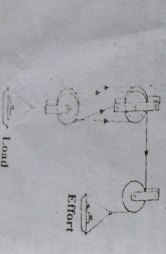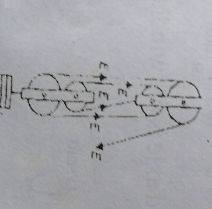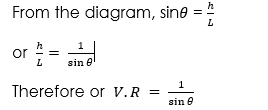Back to: PHYSICS SS2
Welcome to class!
In today’s class, we will be talking about mechanical energy. Enjoy the class!
Mechanical Energy

Over the centuries man has always tried to make the physical task easier. He has invented various tools to accomplish this, as early as the Stone Age, man invented tools made from stone for cutting, farming and hunting. Today machines range from simple ones such as levers, inclined planes, pulleys etc. to move complex machines such as sewing machines, bicycles, etc. complex machines are combinations of a large number of simple machines put together.
WHAT IS A MACHINE?
A simple machine is a device using which work is done more conveniently. It is a device in which a force (called effort) applied at one point is used to overcome another force (called load) at some other point.
PERFORMANCE OF MACHINES
To describe the performance of a machine we use some terms such as mechanical advantage, velocity ratio and efficiency.
MECHANICAL ADVANTAGE (M.A)
Mechanical Advantage is defined as the ratio of load to the effort.
i.e. M.A = load/effort
This shows the ability of the machine to overcome a large force (load) with a small force (effort). For example, if an effort of 4N applied to a machine at one point enables the machine to carry a load of 20N at another point, then the M.A is 20N/4N = 5
This means that the machine magnifies the effort of the applied effort five times. Another name for M.A is force ratio.
VELOCITY RATIO (V.R)
Velocity ratio is defined as the ratio of the distance moved by the effort to the distance moved by the load.
![]()
If a machine, for instance, during the operation has its effort arm moves through a distance of 10cm while the load moves a distance of 2.5cm, then the velocity ratio of the machine is:
V.R = 10/2.5 = 4
EFFICIENCY
Energy used by the machine in moving a load is known as energy output. It is also equal to the work done by the machine on the load. Efficiency is a measure of the fraction of the energy supplied that is used by the machine in moving load.

As can be seen, it is difficult if not impossible for a machine to utilize all the energy supplied to it in carrying the load. That is, there is no machine whose efficiency is 100%. Such machines are called ideal machine. The real machine has efficiency less than 100% because part of the energy supplied is used to overcome friction.
Types of simple machine
- Levers
- Pulley
- Inclined plane
- Wedge
- Screw
- Hydraulic press
- Wheel and
- Gear wheels
The Lever
A lever is a rigid body (usually in front of a bar or rod) supported at one point, about which it rotates. The point of support is known as the fulcrum. In other words, the operation of a lever is based on the principle of the moment. We have three (3) classes of lever depending on the relative position of the load, fulcrum and the effort. These are stated below.
(i) In first-class (order) lever, the fulcrum is in-between the load and the effort.

Examples are pair of scissors, pliers, craw-hammer, see-saw

(ii) In second-order lever, the load is in between the fulcrum and effort.

Examples are Wheelbarrow, nutcrackers etc.


Some examples of the three classes of levers and their practical applications are summarized below.
| Classes of Levers | Examples | Applications |
| First | (i) Scissors | Cutting |
| (ii) Pliers | Gripping wires | |
| (iii) See-saw | Entertainment | |
| (iv) Claw-hammer | Removing nails | |
| Second | (i) Bottle-top opener | Removing the crown of bottled drinks. |
| (ii) Wheelbarrow | Moving heavy objects | |
| Third | (i) Human fore-arm | Lifting loads |
| (ii) Forceps/Twisters | Used in holding for dissection or surgery | |
| (iii) Sugar tong | Lifting cubes of sugar |
Wheel and axle
This machine consists of a wheel and cylinder of small diameter (the axle). These are fitted together in such a way that they rotate about the same axis. The load is attached to the axle using a rope wound around it. The effort is applied to the handle of the wheel.
![]()
A practical example of the wheel and axle is the windlass used for lifting water from deep wells.
The Pulleys
A simple pulley essentially consists of a wheel with a groove in its rim and a rope passes round the groove. A single fixed pulley system is shown below:

For the single pulley shown above, V.r = 1

The diagram above shows a single movable pulley.
The V.R = 2
Practical Applications of Pulley
- Lifting and moving loads
- In cranes used in wharf and construction sites to lift heavy loads such as containers, motor vehicles, bags of cement, etc.
- In mathematical workshop to lift heavy engines.
- In towing vans used for recovering broken down vehicles.
Inclined Planes
An inclined plane is simply a plane surface slanting or inclined to the horizontal. It could be a plank or ladder with one end resting on the ground and the other end raised above the ground.

V.R = Lenght of plane/Height of plane

The V.R of inclined plane depends on the angle of inclination.
NOTE: A wedge is another form of an inclined plane.
Application of Inclined Plane
Inclined planes are used in moving heavy goods from the ground to small heights above the ground. This is often seen when loading barrels of oil into Lorries or Pick-up vans. Builders also make use to inclined planes to facilitate the lifting of heavy items from the ground.
Application of Screw
There are many types of screw. We have the screw jack, the screw nail and wood borers. In all, a screw essentially consists of a cylinder with the threads spiral around it.
Hydraulic Press
If the pressure is applied at any point in a liquid, the pressure is transmitted equally to all parts of the liquid. This happens because liquids are almost incompressible. Examples of the hydraulic machine are:
- hydraulic press
- hydraulic fork
- hydraulic brakes
In any hydraulic system, there are always two cylinders. The effort cylinder is small while the load cylinder is bigger. A small effort applied at the small cylinder is transmitted to pressure in every part to the liquid in the large cylinder. The velocity ratio of the hydraulic press is given as:

Application
This machine has numerous uses such as:
- The compression of soft materials such as waste paper and cotton into compact bales.
- Shaping of motorcar bodies
- Forging of steel plate and light alloys
- Car brake system.
WORKED EXAMPLE
(1) An effort of 50N is applied to lift a load of 100N with the aid of a simple machine. Calculate the mechanical advantage.
Solution
Given parameters
Load = 100N
Effort = 50N
M.A = Unknown
M.A = 100/50
M.A = 2
In our next class, we will be talking about Measurement of Temperature. We hope you enjoyed the class.
Should you have any further question, feel free to ask in the comment section below and trust us to respond as soon as possible.
